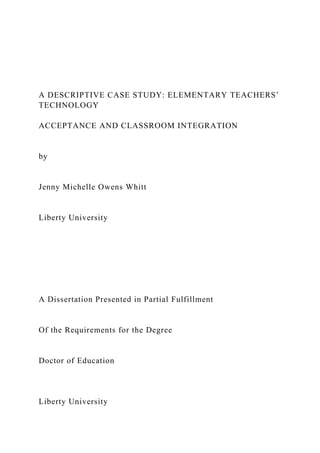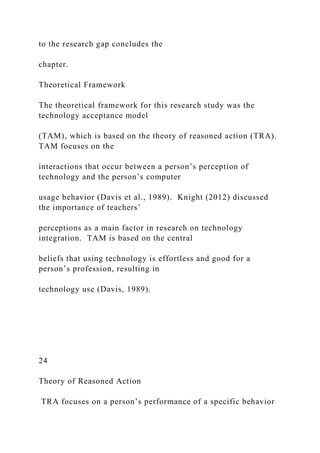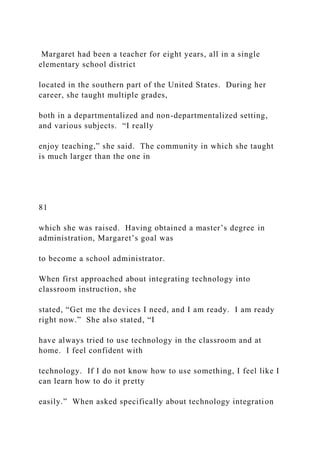This dissertation explores elementary teachers' technology acceptance and integration within a student-supported professional development model, emphasizing the influence of effective training on teachers' perceived ease of use and actual use of technology. Utilizing the Technology Acceptance Model (TAM) as a theoretical framework, the study identifies key themes in teachers' experiences and the necessity of long-term, supportive professional development. It concludes that there are significant gaps in the current literature regarding effective technology training models that include student support, which hampers integration in classroom instruction.









































































































































![used for research. Notes included what I, as the researcher,
saw, heard, observed, and did
(Brinkmann, 2012). I also created an audit trail consisting of
notes created while conducting all
professional development sessions and archival data consisting
of observations conducted yearly
as part of program evaluation in both the 2013-14 and 2014-15
school years. Dependability was
achieved during data analysis. Manual errors were eliminated
by uploading the face-to-face
interviews and archival data consisting of observations
conducted yearly during the 2013-14 and
2014-15 school years as part of program evaluation into
NVivo™ software.
Confirmability ensures that the results of this descriptive case
study were supported by
the participants and occurred independently of the researcher
(Brinkmann, 2012). To achieve the
accuracy stressed by Yin (2013) as being important, I remained
focused on data collection
methods and analysis. Furthermore, I conducted an audit trail
(which Brinkmann [2012] advises
doing as a means to address confirmability), outlining data
collection and data analysis](https://image.slidesharecdn.com/adescriptivecasestudyelementaryteacherstechnology-221224085317-07d2e748/85/A-DESCRIPTIVE-CASE-STUDY-ELEMENTARY-TEACHERS-TECHNOLOGY-docx-138-320.jpg)




















































![always try to use the Internet in as many cases or occasions as
possible during classroom
instruction, with a five, strongly agree. Mary confirmed that
her increased confidence level
would impact her teaching when she stated:
I would definitely use technology again in my classroom now
that I have had some
training where it is hands on. I have a student-support system
right within the classroom
now. It gives me that confidence to know if I do not know the
answer, that they might
know [it].
Throughout observations of Mary conducted during the 2013-
14 and 2014-15 school
years, she always exhibited technology integration. Examples
included using the overhead
projector, iPads™, laptops, the Internet, specific applications,
and programs. An example of
Mary’s acceptance and integration occurred during an
observation conducted in March 2015.
Both Mary and her students were using technology, and she
effectively modeled the platform.](https://image.slidesharecdn.com/adescriptivecasestudyelementaryteacherstechnology-221224085317-07d2e748/85/A-DESCRIPTIVE-CASE-STUDY-ELEMENTARY-TEACHERS-TECHNOLOGY-docx-191-320.jpg)

































































































































![TO PARTICIPATE IN A DOCTORIAL RESEARCH PROJECT
Date:
[Recipient]
Dear [Recipient]:
As a graduate student in the Department of Education at Liberty
University, I am conducting
research as part of the requirements for a Doctor of Education
degree. The purpose of my
research is to inviting you to examine technology acceptance
and classroom integration in
context to a student-supported professional development model.
I am writing to invite you to
participate in my study.
If you are a teacher whom participated in student-supported
technology professional
development provided by me during the 2013-14 and/or 2014-15
school year and will willing to
participate, you will
• Complete an on-line survey conducted through Survey
Monkey®, which should take
approximately five minutes](https://image.slidesharecdn.com/adescriptivecasestudyelementaryteacherstechnology-221224085317-07d2e748/85/A-DESCRIPTIVE-CASE-STUDY-ELEMENTARY-TEACHERS-TECHNOLOGY-docx-321-320.jpg)






![withdraw at any time without
affecting those relationships.
How to Withdraw from the Study:
If you choose to withdraw from the study, please contact the
researcher at the email
address/phone number included in the next paragraph. Should
you choose to withdraw, data
collected from you will be destroyed immediately and will not
be included in this study.
Contacts and Questions:
The researcher conducting this study is Jenny Michelle Owens
Whitt. You may ask any
questions you have now. If you have questions later, you are
encouraged to contact her at
[email protected] or 816-592-9871. You may also contact the
research’s faculty advisor, Dr.
Jennifer Courduff, at jlcourduf[email protected]
If you have any questions or concerns regarding this study and
would like to talk to someone
other than the researcher, you are encouraged to contact the
Institutional Review Board, 1971
University Blvd, Green Hall Suite 1887, Lynchburg, VA 24515
or email at [email protected]
Please notify the researcher if you would like a copy of this
information to keep for your records.
Statement of Consent:
I have read and understood the above information. I have asked
and received answers to my](https://image.slidesharecdn.com/adescriptivecasestudyelementaryteacherstechnology-221224085317-07d2e748/85/A-DESCRIPTIVE-CASE-STUDY-ELEMENTARY-TEACHERS-TECHNOLOGY-docx-328-320.jpg)




















































































































































































































































































